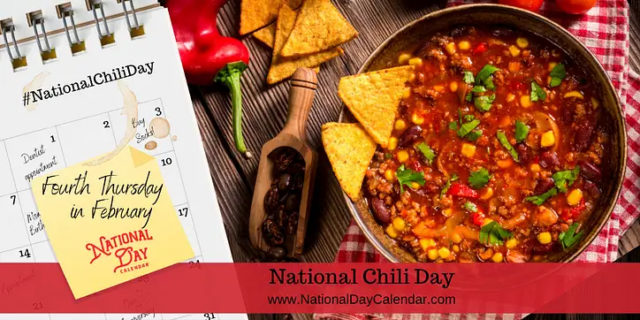
The fourth Thursday in February honors one of America’s favorite winter dishes–chili, which is also known as chili con carne (chili with meat).
- In Spanish, chili refers to “chili pepper” and carne means “meat”.
- Chili is often a favorite dish in cook-offs.
- American frontier settlers used a “chili” recipe of dried beef, suet, dried chili peppers and salt, which was all pounded together, formed into bricks and dried. The bricks could then be boiled in pots on the trails.
- During the 1880’s in San Antonio, Texas, a Latino woman nicknamed “Chili Queens” sold stew they called “chili” made with dried red chiles and beef from open-air stalls at the Military Plaza Mercado. They made their chili at home, loaded it onto colorful chili wagons, and transported the wagons and chili to the plaza. They built mesquite fires on the square to keep the chili warm and dished out chili to customers who sat on wooden stools to eat their fiery stew.
- At the Columbian Exposition in Chicago in 1893, the San Antonio Chili Stand helped people from all over the United States appreciate the taste of chili. Because San Antonio was a significant tourist destination, it helped Texas-style chili con carne spread throughout the South and West.
- In 1977, chili manufacturers in the state of Texas successfully lobbied the state legislature to have chili proclaimed the official “state food” of Texas “in recognition of the fact that the only real ‘bowl of red’ is that prepared by Texans.”
- Before World War II, hundreds of small, family-run chili parlors (also known as chili joints) were found popping up throughout the state of Texas as well as other places in the United States. Each new chili parlor usually had a claim to some kind of secret recipe.
- Chili con carne, meaning “chili with meat” and commonly known in American English as simply “chili”, is a spicy stew containing chili peppers, meat (usually beef), and often tomatoes and beans.
- A teaspoon of red chili powder meets the recommended daily allowance for Vitamin A. Vitamin A plays an important role in vision and bone growth.
- “Wish I had time for just one more bowl of chili.” – Alleged dying words of Kit Carson
- Christopher Columbus discovered chili peppers when he discovered the Americas in 1493.
- There are 140 varieties of chili peppers grown in Mexico alone.
- According to What’s Cooking America, the first recorded batch of chili con carne in America was made in 1731 by a group of women who had emigrated from the Spanish Canary Islands, which historians noted not as “chili” but as a “spicy Spanish stew.”
- The green chili pepper has been growing in the United States – what is now New Mexico – for more than 400 years.
- Chili peppers were used in ancient cuisines in Europe, the Caribbean, Asia and the Middle East.
- The first chili cook-off took place in 1967 in Terlinga, Texas, a border town about 400 miles west of chili’s alleged birthplace, San Antonio. It ended in a tie between a native Texan and (surprisingly) a New Yorker, but chili cook-offs are still held there today.
- U.S. President Lyndon B. Johnson famously loved chili. The White House received so many requests for the family recipe that Lady Bird Johnson, the First lady, had the recipe printed on cards to be mailed out.
- William Gerard Tobin, former Texas Ranger, hotel proprietor, and an advocate of Texas-type Mexican food negotiated with the United States government to sell canned chili to the army and navy.
- In 1895 Lyman T. Davis of Corsicana, Texas sold chili from the back of a wagon; you could obtain a bowl for 5 cents (and all the crackers you wanted were free). In 1921 he began to can the chili and called it “Wolf Brand” (named after his pet wolf Kaiser Bill).
- In 1924 oil was discovered on Mr. Davis’ property. He sold the chili business. The new owners used Model T Ford trucks with cabs shaped like chili cans and painted to resemble the Wolf Brand label. A live wolf was caged in the back of each truck. Today the company is owned by Stokley-Van Camp in Dallas, Texas.
- Chili peppers originated in Mexico. After the Colombian Exchange, many cultivars of chili pepper spread across the world, used for both food and traditional medicine.
- China is the world’s biggest producer of green chili peppers, providing half of the global total.
- Christopher Columbus was one of the first Europeans to encounter chili peppers in the Caribbean and called them “peppers” because they, like the black pepper, have a spicy, hot taste.
- Diego Alvarez Chanca, a physician on Columbus’ second voyage to the West Indies in 1493, brought the first chili peppers to Spain and first wrote about their medicinal effects in 1494.
- For the first 100 years after being introduced to chili peppers in the 1600s, the Japanese put them in their socks to keep their toes warm instead of eating them.
- Capsaicin extracted from chili peppers is used in pepper spray as an irritant, a form of a less lethal weapon.
- Capsaicin, the chemical found in chili peppers that makes them hot, is used as an analgesic in topical ointments, nasal sprays, and dermal patches to relieve pain.
- Chili peppers help you burn more calories by raising the body’s core temperature during digestion. What’s more, they trigger a reaction in your gut that tells your nervous system to produce more brown fat, a healthy fat that expends calories.
- Chili peppers alleviate sore muscles and tame arthritis thanks to endorphins, and by inhibiting substance P, a neuropeptide that causes inflammation.
- Thanks to capsaicin and its relatives, “capsaicinoids,” chili peppers improve heart health in a couple of ways. First, they lower cholesterol levels by reducing accumulation of cholesterol in the body and increasing its breakdown and excretion. Second, they block the action of a gene that makes arteries contract and restricts the blood flow to the heart and other organs.
- Chili peppers have been found to prevent the development of certain types of cancer—especially, prostate cancer. How? Scientists theorize that the peppers trigger something called apoptosis, a type of “cell suicide” that encourages the turnover of cells. These peppers also contain a lot of carotenoids and flavonoids, which scavenge free radicals in our system. Free radicals have been known to cause cancer.
- As a general rule of thumb, the smaller the pepper, the hotter it is.
- There are only 40 calories in 100 grams (3.5 ounces) of chili pepper. Chili pepper is a very good source of Vitamin A, Vitamin C, Vitamin K, Vitamin B6, Potassium, Copper and Manganese and a good source of Dietary Fiber, Thiamin, Riboflavin, Niacin, Folate, Iron, Magnesium and Phosphorus.
- In 1860 the Texas version of bread and water was a stew of the cheapest available ingredients (tough beef that was hacked fine and chiles and spices that was boiled in water to an edible consistency). The “prisoner’s plight” became a status symbol of the Texas prisons and the inmates used to rate jails on the quality of their chili. The Texas prison system made such good chili that freed inmates often wrote for the recipe, saying what they missed most after leaving was a really good bowl of chili.
Sources:












